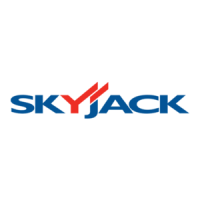SJ82 T, SJ86 T 213205AAA
29
Features and devices Section 3 – Familiarization
FAMILIARIZATION
3.4 Features and devices
3.4-1 Drive speed
The drive speed depends on the MEWP conguration
(lowered travel position/elevated travel position).
When the MEWP is in the elevated travel position, the
speed is slower than the speed in the lowered travel
position. Refer to Section 7.4.
3.4-2 Drive direction
The drive function operates in relation to the general
orientation of the turret counterweight on the chassis
(i.e., when the controller handle is forward, the
counterweight faces forward). Thus, the MEWP will
move in the general direction of the controller handle
movement.
3.4-3 Tilt switch
The tilt switch is in the base control console. When the
MEWP tilts more than a predetermined limit:
▪
an alarm makes a sound
▪
a light illuminates
▪
the boom movement and drive functions are
disabled.
WARNING
Tip-over hazard. When the MEWP tilts more than a
predetermined limit, the alarm makes a sound, and
the light illuminates. The platform must be lowered
and retracted immediately. Refer to Section 6.2 for
the instructions on how to recover from an inclined
position. If you do not obey, there is a risk of death
or serious injury.
3.4-4 Platform load sensing system
The platform load-sensing system prevents normal
MEWP movement when the platform is overloaded
and in a stationary position.
The boom position (extension and angle) has an
effect on the platform capacity. Each boom position
zone (high-capacity zone or low-capacity zone) has
a different capacity. Refer to the platform capacity
label(s) for the maximum platform capacity of each
zone.
If the platform is overloaded while in work mode (the
boom is raised more than 15 degrees from horizontal
or is extended more than 6 inches), the load sensing
system disables all usual functions and signals the
operator with an indicator light and an audible alarm.
If the platform is overloaded while in travel mode,
the load sensing system signals the operator with
an indicator light and an audible alarm, but does not
disable any normal functions.
The table in Section 3.4-5 shows the progression of
warnings to the operator, up to the point of overload.
WARNING
If the platform is overloaded because of contact
with an overhead obstruction, do one of the steps
that follow:
▪
Remove the obstruction from the platform.
Then after four seconds, you can operate the
normal functions.
▪
Use the base emergency-power unit to release
the platform from the obstruction (refer to
Section 6.1).
WARNING
Fall hazard. Do not try to free a snagged platform
with the base controls until you remove all
personnel from the platform. If you do not obey,
there is a risk of death or serious injury.

